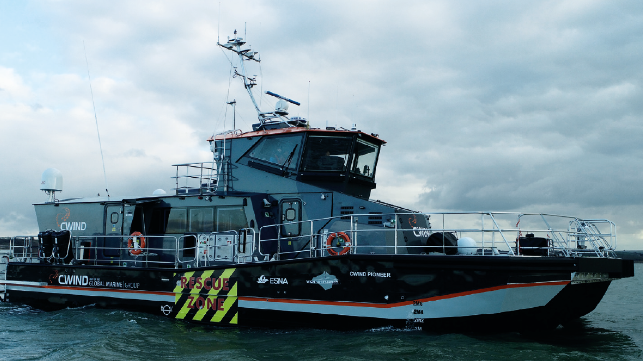CWind Commissions World's First Hybrid Powered Surface-Effect Ship

Crew transfer vessel operator CWind has christened the world's first diesel-electric hybrid powered surface effect ship (SES), the CWind Pioneer.
A surface effect ship rests on both an air cushion and the buoyancy provided by twin catamaran hulls. This arrangement is also known as the "sidewall hovercraft," and it has been used in several high-speed naval vessels in the U.S., Russia and Norway - including Norway's Skjold-class corvettes, the world's fastest combat ships.
“As an SES, [CWind Pioneer] is reducing emissions by offering low resistance at high speed, and the air cushion motion damping is allowing offshore operations in same wave heights as larger vessels. By choosing an SES you can, therefore, reduce emissions by simply building a smaller vessel for the same job," said Trygve H. Espeland, co-founder of naval architecture firm ESNA. "She is not only a step-change for the offshore wind industry, but also for the SES design, as she is the first SES with 100 percent electric air cushion systems."
CWind Pioneer's diesel-electric powerplant can propel the small vessel at a service speed of 44 knots - nearly twice as fast as a conventional CTV. Even with the speed premium, CWind Pioneer is 20 percent more fuel efficient during transit than a standard catamaran CTV. This excludes the savings of the hybrid propulsion system, which will allow the vessel to be a zero emission ship while technicians are carrying out their work on site. Initial studies suggest a 30-50 percent overall fuel savings when compared to conventional vessels, according to CWind.
The fast transit speed also brings more windfarms within practical reach for the day-trip operating cycle of a CTV. Far larger and more expensive service operation vessels (SOVs) with full hotel accommodations are typically required for far-flung sites, but CWind Pioneer can deliver a work crew 45 nm offshore within an hour, changing this calculus.
The CWind Pioneer will be used at Orsted's Borssele 1 and 2 offshore wind farms, about 12 nm off the coast of Zeeland in the English Channel.
